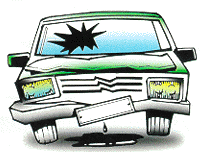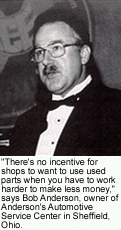Used parts are just that — used and abused," said one shop owner in the 1999 BodyShop Business Industry Profile.
"I like giving the customer new parts as opposed to junkyard damaged and worn parts," said another respondent.
"If the fit is acceptable, aftermarket parts are less work [than used parts]," said yet another.
With responses like that, it’s not hard to decipher that many collision repairers dislike using used or salvage crash parts.
Still, used parts do have a place and a purpose in the crash-parts market: They offer repairers, insurers and consumers an alternative to new original-equipment (OE) parts. They also serve as competition, which helps keep prices in check.
Still, repairers fight the use of used parts. According to the Automotive Service Association (ASA), the total collision repair market is estimated to be $21.1 billion a year. Of that total, $10 billion is attributed to parts, says the Automotive Body Parts Association (ABPA). Of the total amount spent on parts:
• 85 percent is spent on new OE parts;
• 10 percent is spent on non-OEM and re-manufactured parts; and
• 5 percent is spent on used parts.
Why such a lack of support? Many in the industry cite the fact that it’s almost impossible to receive used parts with no damage to clean up as one of the biggest obstacles. Some say they’re not compensated for the increased time and labor it takes to make a used part usable. Still others say information providers need to recognize how many steps are really necessary when working with recycled parts. And that’s not the end of the complaint list.
Can the industry overcome these and other obstacles and help turn used parts into a more viable alternative to new OE crash parts? With a few alterations, many industry members say yes.

Parts Problems
Most collision repairers don’t have a problem with used parts; they have a problem with the lack of compensation afforded them when using used parts.
"There’s no incentive for shops to want to use used parts when you have to work harder to make less money," says Bob Anderson, owner of Anderson’s Automotive Service Center in Sheffield, Ohio.
This deficiency in compensation comes on two levels.
First, repairers across the country report that insurers, by and large, only allow a 20 to 25 percent mark up on used parts. In contrast, when repairers work with new parts, a mark up of 25 to 30 percent is pretty standard.
"In a repair business, there are two components that we need to survive: We have to make a profit on part sales and we have to make a profit on labor sales," says Anderson. "You can’t make it on one and not the other and still stay in business."
That leads to the second problem with compensation: When you use used parts, estimating-system labor times are equal to — and sometimes less than — that of new parts. But it takes more time, say repairers, to make a used part usable, especially when many of them have undetected damage, corrosion and paint problems.
"The biggest problem we have right now is with the information providers," says Jim Busch, owner of Busch Collision in Issaquah, Wash. "We’re required by law to clearly identify whether we use a salvaged part. … When I do that, time is taken away [from the estimate]. But this stuff needs cleaned up and needs additional work."
This creates a lot of friction between insurers and repairers — as if there weren’t enough already — because insurance companies have bought these estimating programs, and if their adjusters aren’t trained to look realistically at the repair, a shop gets an estimate written on unrealistic times. "Rather than messing around [with the part] and arguing or negotiating, the shop calls back the insurer and says, ‘This part wasn’t available. I need a new part.’ " says Busch. "That damages relationships between shops and recyclers, and it’s not dealing honestly with insurers."
The cleanup that repairers aren’t compensated for can often include removing excess paint; repairing or plugging holes; repairing surface imperfections; and removing stripes, decals, adhesive moldings, locks, handles, mirrors, hinges and more — all of which require time and labor.
"The salvage yards like to say that they’re in the recycling business and that they sell recycled parts. I don’t agree with that," says Anderson. "They sell parts that I have to repair before they’re actually recyclable parts. So really, they’re selling me a used part and I’m in the recycling business to make that part re-usable — but I’m not getting paid for it."
But unfair compensation is only part of the equation. Other problems include inaccurate parts-locator systems, delayed delivery and a burdensome return process. Shop owners also say it takes a great deal of administrative time to locate, receive and pay for used parts. Many parts come COD in UPS boxes, and shops are expected to pay before they even examine the part. If the salvage yard isn’t local and shops don’t use it often, it becomes burdensome because shops have to pay to send back the part. Then they spend more time finding another part — which is uncompensated time — and the job doesn’t get done on schedule.
Damaged parts are also a burden on shops. "The insurance company says that if I get a part and there’s a scratch in it, they want me to call the salvage yard and make them lower their price to afford me the time to do the repairs," says Anderson. "Now, I’m caught up in a part that they sourced to save money, and I have to do all the work and negotiate. That’s not fair."
Though many repairers admit to experiencing the same difficulties, others say a lot of it depends on the vendor — and, like in any business, there are good ones and bad ones.
"We have an excellent vendor — probably the best one in the country," says Kevin Caldwell, owner of Autobody by Caldwell in Laguna Hills, Calif. "But any time he gets a part from another yard, we have a problem with it."

Salvageable Solutions
Are there any solutions for making what appears to be a pile of unwanted, used sheet metal a more feasible parts alternative?
Many say that if the insurance industry were more realistic about used parts, the repair industry would make a turnaround.
"The repair industry wants to do the right thing," says Anderson. "They want the ability to fix cars, and that’s why used parts are a viable alternative. But the insurance industry has to … pay a repair shop what they’re entitled to. … That’s a fair way of doing business."
Others in the industry cite three main solutions to the dilemma over used parts:
1. Information providers need to solve estimating-system database problems.
2. Insurance companies need to allow for reasonable markup for body shops.
3. Insurance companies need to be more reasonable about cleanup time and trim down time.
"If the insurance industry would be more fair in the profit structure of the utilization of used parts, it would be more advantageous for people to use them," says Anderson. "Likewise, if the information providers would be more fair in their times, which affect our compensation, repair shops wouldn’t resist using [used parts] as much as they do."
While most of those solutions focus on changes made by insurers and information providers, changes have already come in the used-parts sector itself, which has clearly improved from five years ago when there were no computerized systems or databases. Electronic solutions for locating and inventorying salvage parts has transformed the traditional salvage-yard business model and put salvage yards on par with the insurance industry.
Changes have also come in the form of consolidation. Before these consolidators took notice, the auto-recycling business was dominated by independent, family-owned facilities.
"I think [consolidation] has raised the bar," says Mark Buessing, president of the Automotive Recyclers Association (ARA). "Last year, with LKQ coming in, there was a lot of anxiety and a lot of excitement.
"Anybody whose doing a good job is, obviously, going to be an acquisition target. But if they’re not interested [in selling], they’re capable of competing. I think the anxiety is felt by the segment of the industry that isn’t up to par."
Ford Motor Co. — the world’s second-largest automaker — is one of those consolidators, and its entry into the used-parts business has garnered a lot of attention. In April of this year, Ford purchased its first salvage yard in Florida. Since then, other facilities have been acquired — mostly big players in specific markets, businesses with more than one facility and a strong management structure that are doing several million dollars in business.
"I think, if anything, [Ford’s entry into the salvage-parts market] brings more credibility to our industry," says Buessing. "Here’s a major manufacturer that’s recognized the significance of recycling."
Despite attempts, Ford representatives were unavailable for comment.
In addition to the changes consolidation will bring about, a national uniform titling bill currently under consideration in Congress could have a significant effect on the used-parts business — if it includes an adequate percentage definition of what a non-repairable vehicle is. With such a provision, damaged vehicles with repairs exceeding a specified percentage of its fair market value would be branded as "salvage" and couldn’t be purchased by rebuilders, who are salvage yards’ biggest competition when it comes to acquiring vehicles.
Under current laws, both rebuilders and salvage yards are allowed to bid on totaled vehicles at auctions. Oftentimes, rebuilders will win a bidding war because a yard can only pay so much for an entire vehicle and still make a profit on its individual parts. A national salvage titling bill would limit the number of vehicles rebuilders could purchase, fix and put back on the roads, thereby creating a larger supply of vehicles for salvage yards and an increased supply of parts available to collision shops.
More Than Scrap Metal
Repairers, for the most part, don’t have a problem with using salvage parts. What they do have a problem with is not being compensated for extra cleanup and work that goes into making a used part usable.
"The insurance industry has an obligation to pay for the repairs," says Anderson. "And they also have every right to look at alternatives like used parts for that repair. But they also have to recognize what [repairers] have to do to save them money."
It’s to the insurance industry’s advantage to use salvage parts. But if used parts are ever going to be a feasible alternative to new OE parts, repairers must also benefit. The bottom line: Pay repairers for what they have to do and, it seems, they’d gladly use salvage parts.
Like many other issues facing the collision repair industry, it will take industry-wide support to bring about change. Cost shifting to make up the difference or claiming that a used part wasn’t available and requesting OE parts aren’t the answers. Through communication and honest dealings with insurers and recyclers alike, you can help determine whether the used-parts market will be salvaged — or simply left for scrap.
Writer Melissa McGee is managing editor of BodyShop Business.
|
Recycle-Parts Request Form |













